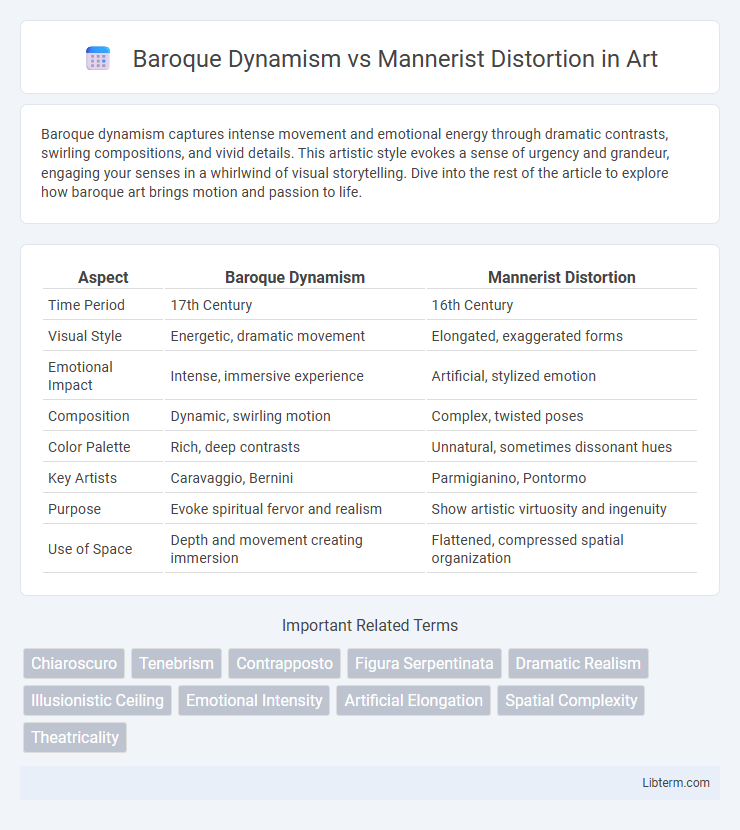Baroque dynamism captures intense movement and emotional energy through dramatic contrasts, swirling compositions, and vivid details. This artistic style evokes a sense of urgency and grandeur, engaging your senses in a whirlwind of visual storytelling. Dive into the rest of the article to explore how baroque art brings motion and passion to life.
Table of Comparison
| Aspect | Baroque Dynamism | Mannerist Distortion |
|---|---|---|
| Time Period | 17th Century | 16th Century |
| Visual Style | Energetic, dramatic movement | Elongated, exaggerated forms |
| Emotional Impact | Intense, immersive experience | Artificial, stylized emotion |
| Composition | Dynamic, swirling motion | Complex, twisted poses |
| Color Palette | Rich, deep contrasts | Unnatural, sometimes dissonant hues |
| Key Artists | Caravaggio, Bernini | Parmigianino, Pontormo |
| Purpose | Evoke spiritual fervor and realism | Show artistic virtuosity and ingenuity |
| Use of Space | Depth and movement creating immersion | Flattened, compressed spatial organization |
Defining Baroque Dynamism: Energetic Movements in Art
Baroque dynamism emphasizes energetic movements and dramatic intensity, characterized by swirling compositions, strong contrasts of light and shadow, and a sense of immediacy that engages viewers emotionally. This artistic style contrasts with Mannerist distortion, which relies on elongated forms and artificial poses to create tension and instability. Baroque artists like Caravaggio and Bernini utilized dynamic motion to evoke powerful sensory experiences, reflecting the era's emphasis on emotional depth and theatricality.
Mannerist Distortion: Elongation and Unconventional Proportions
Mannerist distortion is characterized by elongation and unconventional proportions, creating figures that appear stretched and often unrealistic, challenging classical ideals of balance. This artistic style emphasizes artificiality and complexity, leading to exaggerated poses and spatial ambiguity that evoke tension and expressiveness. Such distortion contrasts sharply with the Baroque dynamism, as Mannerism prioritizes stylized elegance over naturalistic movement and emotional immediacy.
Key Historical Contexts: Mannerism and Baroque Eras
The Baroque era (circa 1600-1750) emphasized dynamism through dramatic movement and emotional intensity, reflecting the Counter-Reformation's goal to inspire faith via art. Mannerism, preceding Baroque (circa 1520-1600), featured stylized distortion and elongated forms, expressing tension and complexity amid the political instability of the late Renaissance. Key figures such as Caravaggio in Baroque and Pontormo in Mannerism illustrate the shift from artificial elegance to vigorous realism in European art history.
Iconic Artists: From Parmigianino to Caravaggio
Parmigianino's work epitomizes Mannerist distortion with elongated forms and exaggerated poses that challenge natural proportions, as seen in his iconic "Madonna with the Long Neck." In contrast, Caravaggio's Baroque dynamism captivates through intense realism, dramatic chiaroscuro, and emotional immediacy, redefining religious narratives in paintings like "The Calling of Saint Matthew." The transition from Mannerist stylization to Baroque vitality marks a pivotal evolution in art history, emphasizing naturalism and movement over artificial elegance.
Composition and Space: Contrasts in Artistic Approach
Baroque dynamism emphasizes dramatic movement and spatial depth through diagonal compositions and the use of chiaroscuro to create intense contrasts between light and shadow, enhancing the illusion of three-dimensional space. Mannerist distortion disrupts natural proportions and spatial coherence by elongating figures and employing ambiguous, compressed spatial arrangements that evoke tension and artificiality. The Baroque approach aims for immersive realism and emotional engagement, while Mannerism favors intellectual complexity and stylized elegance within constrained spatial frameworks.
Emotional Impact: Drama vs. Ambiguity
Baroque dynamism emphasizes intense emotional impact through dramatic movement, vivid contrasts, and theatrical compositions that engage viewers in a powerful sensory experience. Mannerist distortion relies on elongated forms and ambiguous spatial relationships to create tension and psychological unease, evoking a complex, introspective emotional response. The Baroque style's clear emotional narrative contrasts with Mannerism's subtle ambiguity, highlighting differing artistic approaches to human emotion and spiritual experience.
Color, Light, and Shadow: Techniques of Both Styles
Baroque dynamism utilizes vivid color contrasts and dramatic chiaroscuro to enhance movement and emotional intensity, emphasizing deep shadows and bright highlights that create a sense of depth and realism. Mannerist distortion, by contrast, employs unnatural color combinations and flattened light to exaggerate form and create an unsettling, artificial atmosphere with minimal shadow gradation. Both styles manipulate light and color strategically, with Baroque prioritizing naturalism and vibrant contrasts while Mannerism favors stylization and expressive ambiguity.
Religious and Secular Symbolism in Both Movements
Baroque dynamism employs dramatic movement and vivid contrasts of light and shadow to evoke emotional intensity and spiritual fervor, often symbolizing divine intervention and the grandeur of the Catholic Church. Mannerist distortion manipulates proportions and spatial ambiguities to express tension and instability, reflecting the uncertainty of the Reformation era and secular humanist themes. Religious symbolism in Baroque art emphasizes miraculous and triumphant narratives, while Mannerist secular symbolism explores complexity and intellectual ambiguity through elongated forms and unconventional poses.
Influence on Later Artistic Developments
Baroque dynamism, characterized by dramatic movement, emotional intensity, and vivid contrasts, significantly influenced the development of Rococo and Neoclassicism by emphasizing theatricality and naturalism in art. Mannerist distortion, with its elongated figures and complex compositions, laid the groundwork for later Expressionism and Surrealism by challenging traditional proportions and creating a sense of emotional tension. Both styles expanded artistic boundaries, contributing to the evolution of visual storytelling and emotional expression in modern art.
Baroque Dynamism vs Mannerist Distortion: Lasting Legacies
Baroque Dynamism's legacy endures in its emphasis on movement, emotional intensity, and dramatic contrasts, influencing contemporary art and architecture focused on immersive experiences. In contrast, Mannerist Distortion leaves a lasting impact through its deliberate ambiguity, elongated forms, and complex compositions that challenge classical proportions and evoke tension. Together, these styles shaped modern aesthetics by contrasting naturalistic vitality with stylized artificiality, creating a rich dialogue in visual expression.
Baroque Dynamism Infographic

 libterm.com
libterm.com